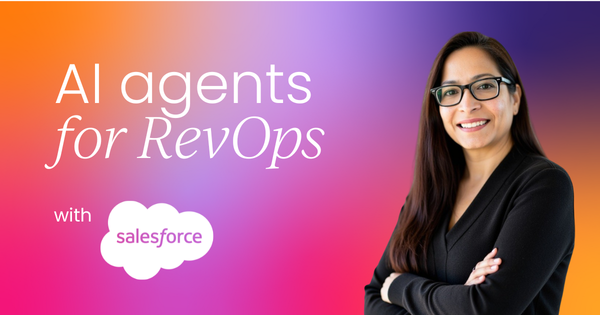Let me start with a confession: we're not armchair quarterbacks at Salesforce. Our CEO Marc Benioff challenges us daily with a simple question - how do we become a truly agentic enterprise?
The answer: By being our own first customer.
Think about it - before any of our solutions reach you, we've already tested them, broken them, fixed them, and made them better. We call this our “Customer Zero” approach, and it's revolutionizing how we think about RevOps.
The RevOps reality check
If you're in revenue operations, you know the drill. Every metric you track, every dashboard you build, every process you optimize - it all comes down to two questions:
- How do we make money?
- How do we save money?
Sound familiar?
Here's what I've learned working with RevOps teams: you own everything.
Whether it's marketing ops, sales ops, or pure revenue ops - you're the glue that connects it all. Without that connection, you might gain 10% efficiency here or there, but you'll never achieve the 70-100% transformation you're after.
From clicks to conversations: our transformation journey
We started our RevOps transformation project with a simple goal: build the best applications with the fewest clicks. Noble intention, right? But then we had our “aha” moment.
What if instead of building more applications, we just built conversations?
Here’s what I mean. We discovered some of our sellers spend their entire day just building quotes. Not selling. Not talking to customers. Just clicking through systems. Meanwhile, another seller who hates systems has someone else doing all the clicking for them. Talk about inefficiency!
That's when we shifted to what we call “Agentic Revenue Transformation.” Instead of forcing people to learn complex systems, we gave them AI teammates they could simply talk to.
Here’s the framework so you can build it too…
The 3-step agent development framework that actually works
Now, here's where it gets practical. We developed a six-step framework for building revenue agents, and I'm going to focus on the first three steps - the ones that matter most to RevOps teams like yours.
Step 1: Define the problem and use case
This is where you shine. Ask yourself:
- What processes need improvement? (Approvals? Deal structuring? Usage reconciliations?)
- Where are you clicking the same button 100 times at month-end?
- What new monetization models need testing?
- Where's the most friction in your process?
Step 2: Define the agent's role
Here's my favorite analogy: agents are like toddlers. You need to teach them, guide them, and help them grow into capable adults. We use a “Jobs to Be Done” (JTBD) framework - essentially writing a job description for your agent.
Will it assist? Recommend? Automate decisions?
Who will use it? What persona does it imitate?
Pro tip: Define your KPIs upfront. Trust me, we learned this the hard way. Executives love dashboards and metrics. Show them deal cycle time reduction, seller productivity gains, or compliance improvements, and you'll get the investment you need.
Step 3: Design the agent experience
Think about your users. Are they sellers who need enterprise deal support? Deal desk teams handling high-volume transactions? Each persona needs a different experience.
Consider how they'll interact:
- Chat-based interfaces (like Slack or Teams)
- Embedded in existing UIs
- API-driven for background processing
Remember, what sellers really want is a quote that wins deals - not 10 pages of forms with thousands of fields.
Real results: what we've achieved
Let me show you what's possible. With our quoting agent, sellers can now:
- Create quotes with specific discounts in one sentence
- Generate multiple quote variations automatically
- Update quantities and pricing without manual calculations
- Get instant ACV calculations and impact analysis
The result? We've cut quote creation time by 75% and dramatically reduced support cases.
The challenges (because nothing's perfect)
I promised honesty, so here it is. We faced challenges:
Data validation was tricky. RevOps deals with financial data - accuracy is non-negotiable. We had to build custom validations initially.
Security concerns popped up. “This is my data!” people said. We learned to implement proper permission sets after a few... let's call them “learning experiences.”
Establishing benchmarks took time. But once we had them, everything clicked.
What's next for your RevOps team?
The future is bright. You can build:
- Deal specialists
- Quote specialists
- Collection agents
- Self-service agents
And here's the kicker - you don't need a team of 25 engineers. Pick one use case, grab three engineers and one RevOps person, choose an archetype, and start experimenting.
The bottom line
RevOps best practices are evolving. The shift from doing to delegating to AI agents isn't just about efficiency - it's about fundamentally reimagining how revenue operations work.
Remember when I mentioned those 500 controls in our quote-to-cash process? We're using agents to reduce that to 400. Not by removing controls, but by making them unnecessary through intelligent automation.
Your sellers don't want to click through systems. They want to have conversations and close deals. Your RevOps team doesn't want to manually reconcile data at month-end. They want to drive strategic initiatives.
AI agents make both possible.
Ready to start?
The path to becoming an agentic enterprise starts with a single agent. Pick your biggest pain point, define the job to be done, and start building. Remember - your first agent won't be perfect. Like teaching a toddler, it takes patience and iteration.
But when you see your sellers saving hours per week, your deal cycles shortening, and your RevOps team focusing on strategy instead of manual tasks - you'll wonder why you didn't start sooner.
This article was adapted from Monica's talk at our Revenue Operations Summit in San Francisco, 2025. Want to attend events like this and stay one step ahead? Check out our upcoming events:


 4 min read
4 min read
 Follow us on LinkedIn
Follow us on LinkedIn



